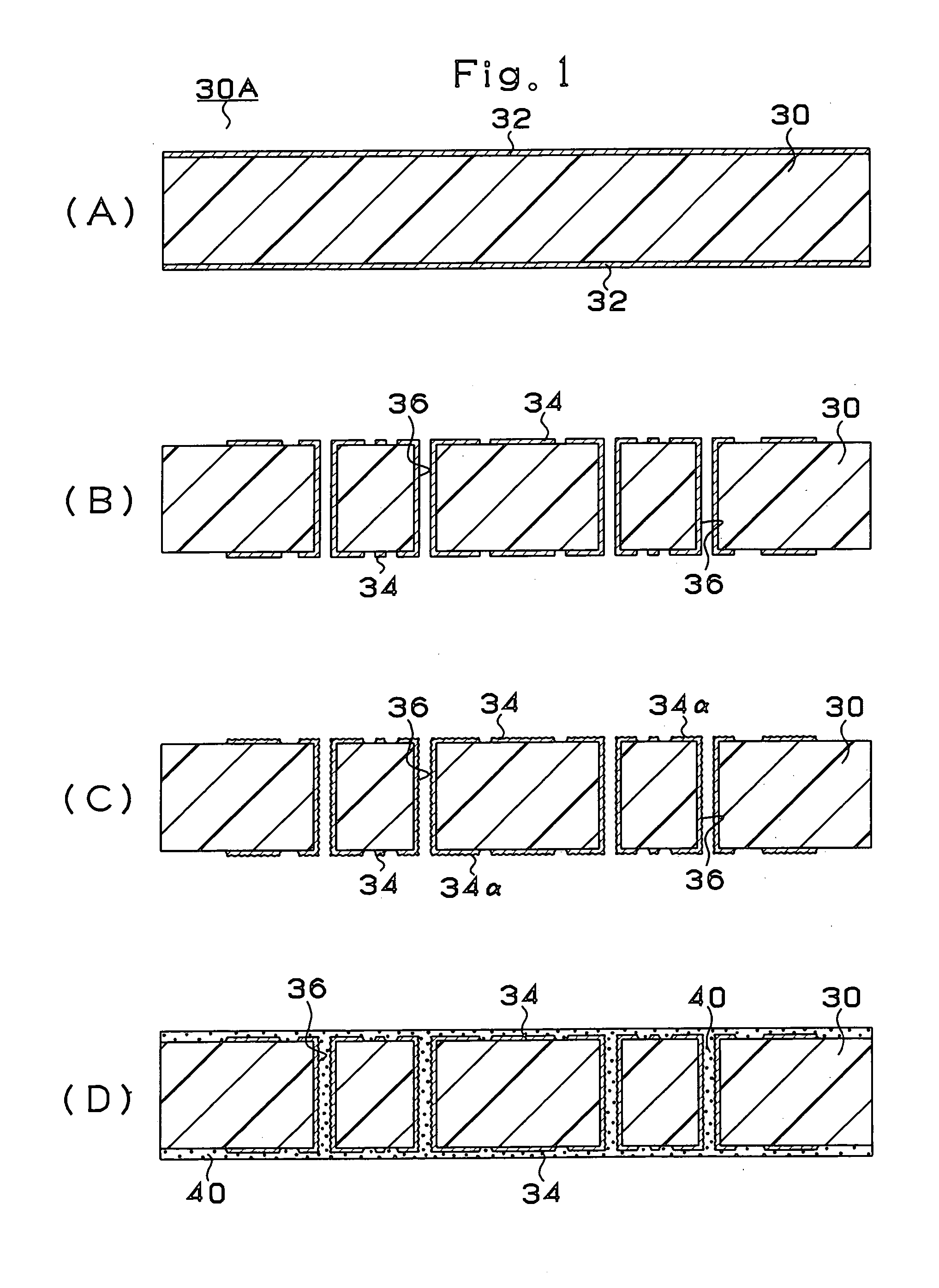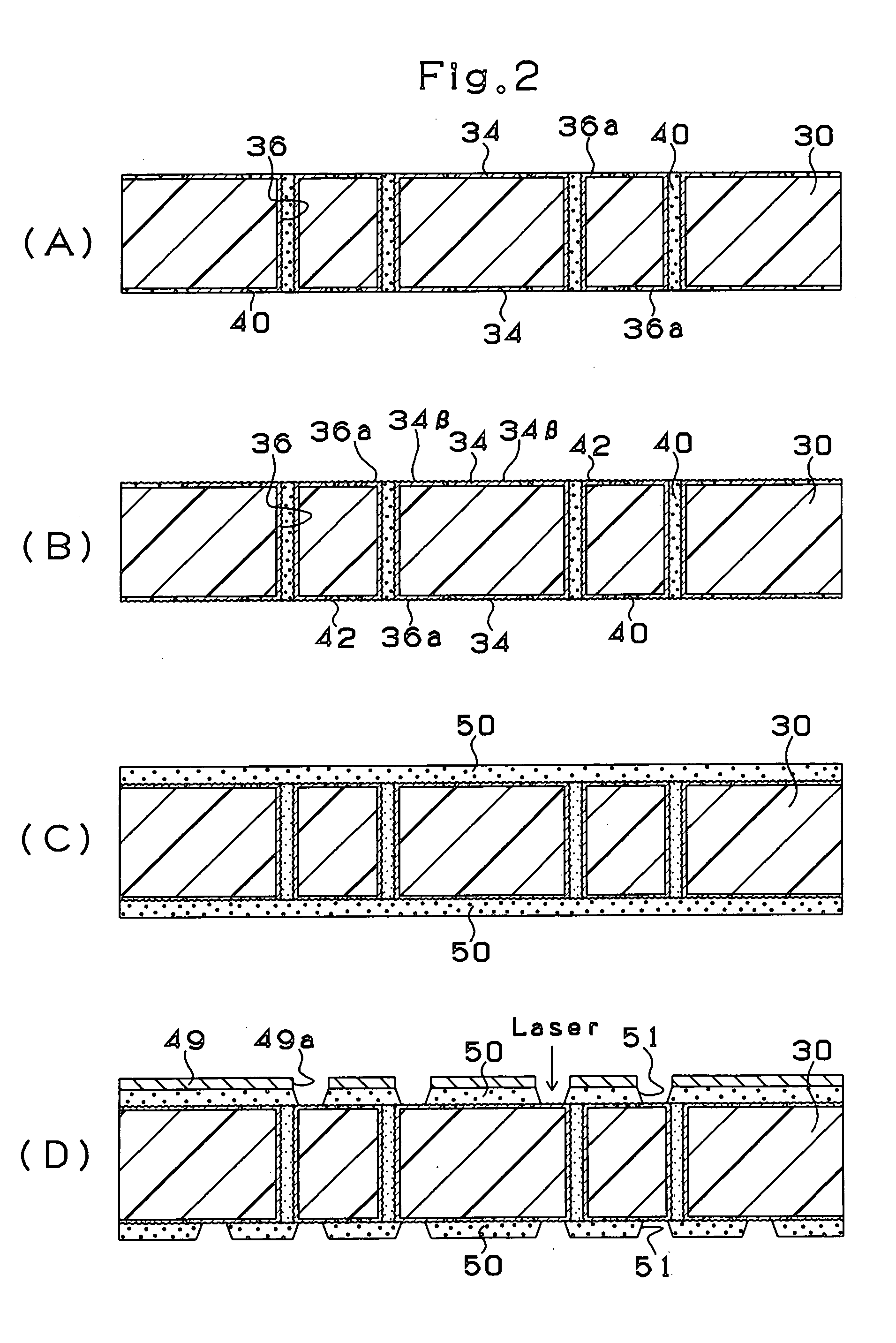Printed wiring board and production method for printed wiring board
a technology of printed wiring and production method, which is applied in the direction of liquid/solution decomposition chemical coating, insulating substrate metal adhesion improvement, and semiconductor/solid-state device details, etc. it can solve the problems of hammering the improvement of electric characteristics, and achieve excellent corrosion resistance, reduce metal resistance, and reduce the voltage drop quantity of the power supply
- Summary
- Abstract
- Description
- Claims
- Application Information
AI Technical Summary
Benefits of technology
Problems solved by technology
Method used
Image
Examples
first embodiment
[0099] The configuration of a printed wiring board according to the first embodiment of the present invention will first be described with reference to FIGS. 6 to 9. FIG. 6 shows the cross-section of a printed wiring board 10, and FIG. 7 shows a state in which an IC chip 90 is mounted on the printed wiring board shown in FIG. 6 and attached to a daughter board 94—side.
[0100] As shown in FIG. 6, the printed wiring board 10 has buildup wiring layers 80A and 80B formed on the front and rear surfaces of a core substrate 30, respectively. Each of the buildup wiring layers 80A and 80B comprises of an interlayer resin insulating layer 50 on which conductor circuits 158 and vias 160 are formed, and an interlayer resin insulating layer 150 on which conductor circuits 158 and vias 160 are formed. The buildup wiring layer 80A and the buildup wiring layer 80B are connected through holes 36 formed in the core substrate 30. A solder resist layer 70 is formed on the interlayer resin insulating la...
second embodiment
[0205] The second embodiment of the present invention will be described hereinafter with reference to the drawings.
[0206] The configuration of a printed wiring board according to the second embodiment of the present invention will first be described with reference to FIGS. 24 to 26. FIG. 24 shows the cross-section of a printed wiring board 10, and FIG. 25 shows a state in which an IC chip 90 is mounted on the printed wiring board shown in FIG. 24.
[0207] As shown in FIG. 24, the printed wiring board 10 has buildup wiring layers 80A and 80B formed on the front and rear surfaces of a core substrate 30, respectively. Each of the buildup wiring layers 80A and 80B comprises of an interlayer resin insulating layer 50 on which conductor circuits 58 and vias 60 are formed, and an interlayer resin insulating layer 150 on which conductor circuits 158 and vias 160 are formed. The buildup wiring layer 80A is connected to the buildup wiring layer 80B via through holes 36 formed in the core subs...
third modification
[Third Modification]
[0225] A printed wiring board 110 according to the third modification of the present invention will next be described with reference to FIG. 32. In the second embodiment stated above, each solder pad 73 comprises of the tin layer 74 formed on the conductor circuit 158 or via 160. In the third modification, by contrast, the solder pad 73 comprises of a gold layer 174 formed on the conductor circuit 158 or via 160. In the third modification, noble metal is used to coat the conductor circuits 158 and the vias 160, thus ensuring that the solder pads 73 have excellent corrosion resistance. In addition, the use of gold lower in resistance than tin can further increase high frequency characteristic, as compared with the first embodiment.
[0226] The thickness of the gold layer 174 is desirably 0.01 to 3 μ / m. If the thickness is less than 0.01 μm, portions which cannot completely cover the conductor circuit 158 or via 160 are generated, adversely influencing strength and ...
PUM
| Property | Measurement | Unit |
|---|---|---|
| frequency | aaaaa | aaaaa |
| frequency | aaaaa | aaaaa |
| thickness | aaaaa | aaaaa |
Abstract
Description
Claims
Application Information
 Login to View More
Login to View More - R&D
- Intellectual Property
- Life Sciences
- Materials
- Tech Scout
- Unparalleled Data Quality
- Higher Quality Content
- 60% Fewer Hallucinations
Browse by: Latest US Patents, China's latest patents, Technical Efficacy Thesaurus, Application Domain, Technology Topic, Popular Technical Reports.
© 2025 PatSnap. All rights reserved.Legal|Privacy policy|Modern Slavery Act Transparency Statement|Sitemap|About US| Contact US: help@patsnap.com



